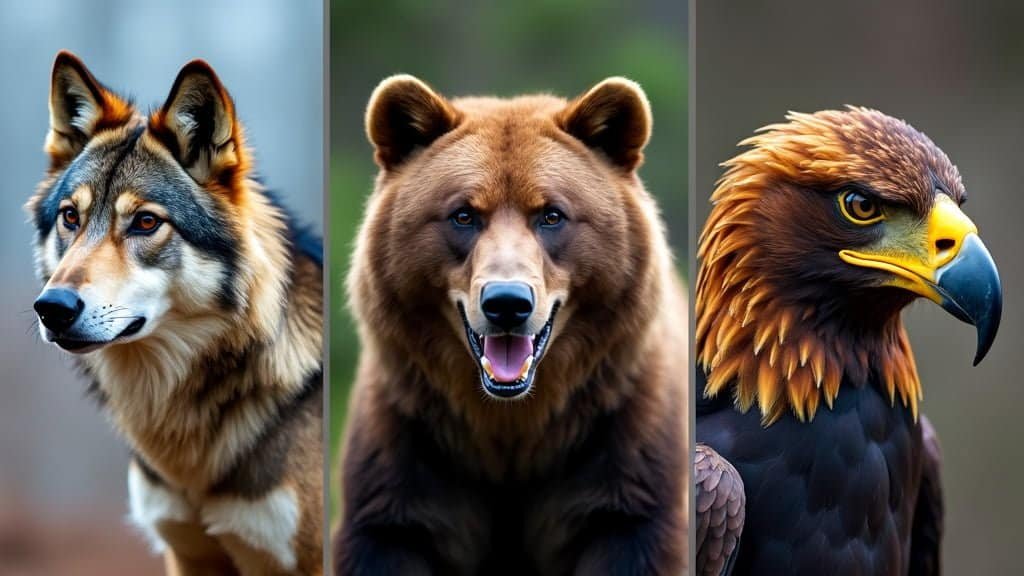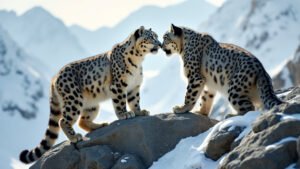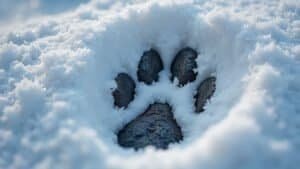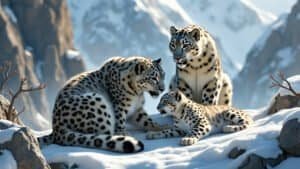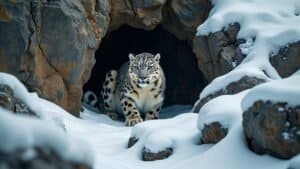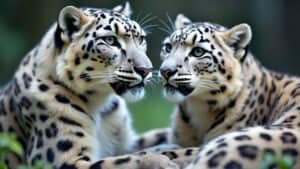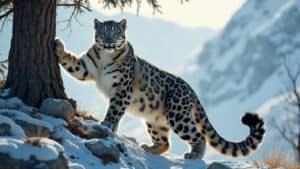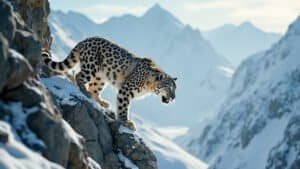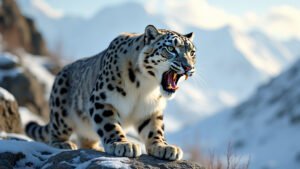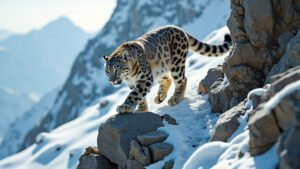Introduction
Snow leopards are solitary, elusive predators native to the mountainous regions of Central and South Asia. They share their harsh, rugged habitats with a variety of other predators, leading to complex interactions that influence their behavior and survival strategies
This article explores how snow leopards interact with other predators in their habitat, focusing on the types of predators they coexist with, competition for food, territorial behavior, and the impact of environmental changes
Understanding these dynamics is crucial for conserving these endangered big cats and maintaining the delicate balance of their ecosystems
What Predators Coexist With Snow Leopards?
Snow leopards share their habitats with a diverse array of predators, each contributing to a complex web of interactions. These predators vary depending on the specific region, but typically include wolves, brown bears, and large birds of prey such as eagles
Understanding the types of predators that coexist with snow leopards is crucial to grasping the intricate dynamics of predator-prey relationships in these mountainous ecosystems
Common Predators in Snow Leopard Habitats
In the cold, rugged terrains of the Himalayas, the Tibetan Plateau, and other high-altitude regions, snow leopards are not the only apex predators. Wolves (Canis lupus) are among the most prominent competitors
They hunt similar prey, such as wild sheep (argali), goats (ibex), and smaller mammals like marmots. Unlike snow leopards, which are solitary hunters, wolves often operate in packs, which can give them an advantage in both hunting and defending territory
Brown bears (Ursus arctos) also inhabit the same regions as snow leopards, particularly in areas like the Altai Mountains. These large omnivores are known to scavenge kills made by snow leopards, creating a competitive dynamic. While bears are less likely to directly confront a snow leopard, their presence at a kill site can lead to the big cat abandoning its meal to avoid conflict
Large birds of prey, particularly eagles, are another group of predators that share the snow leopard’s domain. Although they primarily target smaller mammals and birds, these raptors occasionally compete with snow leopards for food, especially in times of scarcity
The golden eagle (Aquila chrysaetos), for instance, is known to prey on young ungulates that snow leopards might also target
How Other Predators Impact Snow Leopard Populations
The presence of these predators can significantly impact snow leopard populations. For example, wolves, by hunting in packs, can deplete the availability of prey in a given area, indirectly affecting snow leopards’ hunting success
Additionally, scavengers like bears might force snow leopards to abandon kills prematurely, leading to energy loss and increased hunting pressure. These dynamics highlight the importance of prey availability and competition in shaping the behavior and survival of snow leopards
Moreover, interspecies competition isn’t just about direct encounters; it’s also about the broader ecological pressures these predators exert on each other. For instance, in regions where prey is plentiful, snow leopards and wolves might coexist relatively peacefully
However, in areas where prey is scarce, competition can become more intense, leading to shifts in the behavior, territory size, and even population numbers of these predators
Regional Differences in Predator Interactions
The interactions between snow leopards and other predators vary significantly across their range. In the western parts of the snow leopard’s habitat, such as the mountains of Central Asia, the primary competitors might be wolves and brown bears
In contrast, in the eastern regions, including the Tibetan Plateau, the competition may involve different species, such as the red fox (Vulpes vulpes) or the Eurasian lynx (Lynx lynx), which are also predators of similar prey
These regional variations are influenced by factors such as prey availability, habitat structure, and even human activities like hunting and livestock grazing. In some areas, the introduction of new predators or the decline of traditional prey species has led to changes in how snow leopards interact with other carnivores
For instance, increased livestock grazing in certain regions has sometimes led to snow leopards preying more on domestic animals, which can alter their interactions with other predators that also target livestock
Competition for Food Among Snow Leopards and Other Predators
In the harsh environments where snow leopards live, food is often scarce, leading to intense competition among predators
This competition significantly influences the behavior, hunting strategies, and even the survival of snow leopards. Understanding how snow leopards compete for food with other predators is essential for appreciating the delicate balance of these ecosystems
Prey Species Shared by Snow Leopards and Other Predators
Snow leopards primarily prey on large herbivores such as blue sheep (bharal), ibex, and argali, which are also targeted by other predators like wolves and bears. The overlap in diet between snow leopards and these predators creates a competitive environment where each species must constantly vie for the same limited resources
For instance, in the Himalayas, blue sheep are a vital food source not only for snow leopards but also for wolves. Both predators rely heavily on these herbivores to sustain their populations, particularly during the harsh winter months when other prey becomes scarce
Studies have shown that in areas with high densities of wolves, snow leopards may face increased competition for these prey species, potentially affecting their hunting success and overall health
Food Scarcity and Increased Predator Competition
Food scarcity is a defining feature of the mountainous regions where snow leopards live. When prey populations decline due to factors such as disease, harsh weather, or human activities, the competition between snow leopards and other predators intensifies. In these situations, snow leopards must adapt by altering their hunting strategies or expanding their range to find sufficient food
For example, during particularly harsh winters, when herbivores like blue sheep or ibex are less accessible, snow leopards may be forced to hunt smaller mammals or even scavenge carrion. However, these food sources are often less nutritious and can lead to higher energy expenditure during hunting, making survival more challenging
In regions where snow leopards share their habitat with brown bears, the competition for carcasses can be particularly intense. Bears, being opportunistic feeders, are known to take over kills made by snow leopards
This behavior forces snow leopards to abandon their hard-earned meals, often resulting in significant energy loss and forcing them to hunt more frequently to meet their dietary needs
Adaptations to Reduce Competition for Food
To survive in environments where food is scarce and competition is fierce, snow leopards have developed several adaptations. One key adaptation is their solitary nature, which allows them to minimize direct competition with other predators
Unlike wolves, which hunt in packs, snow leopards hunt alone, allowing them to remain inconspicuous and avoid attracting attention from other predators that might steal their kills
Snow leopards also exhibit remarkable stealth and patience in their hunting techniques. They are capable of stalking their prey over long distances, using the rocky terrain to their advantage to get as close as possible before launching an ambush
This stealthy approach reduces the chances of alerting other predators to their presence, thereby minimizing competition
Additionally, snow leopards have large territories that they patrol regularly. By maintaining and defending these territories, snow leopards can ensure access to sufficient prey while reducing the likelihood of encountering other predators
These territories are often marked with scent markings and scratch marks on rocks, signaling to other predators that the area is occupied
Another adaptation that helps reduce competition is the snow leopard’s ability to thrive at higher altitudes than many other predators. By living and hunting in these more extreme environments, snow leopards can access prey species that might be less available to other carnivores, thereby reducing direct competition
Territorial Behavior and Avoidance Strategies
Territoriality plays a crucial role in how snow leopards interact with other predators. These elusive cats maintain and defend large territories, which are essential for ensuring access to prey and minimizing conflicts with other predators
Understanding snow leopard territorial behavior and their strategies for avoiding conflicts with other predators offers insights into their survival in the harsh and competitive environments they inhabit
Snow Leopard Territory and Its Importance
Snow leopards are highly territorial animals, with each individual typically occupying a large home range that can span from 12 to 240 square miles, depending on prey availability and habitat quality
These territories are essential for snow leopards to secure enough food to sustain themselves and their offspring. The size of a snow leopard’s territory is often directly related to the abundance of prey within it; in areas with plentiful prey, territories tend to be smaller, while in regions with scarce prey, snow leopards must cover larger areas to find enough food
Territories are not only about securing food but also about minimizing encounters with other predators. By establishing a well-defined territory, a snow leopard reduces the likelihood of direct competition and potential conflicts with other large carnivores, such as wolves or bears
These territories are marked with various scent markings, including urine, feces, and scratch marks on rocks and trees. These markings serve as a warning to other predators, indicating that the area is already claimed
How Snow Leopards Mark and Defend Their Territory
Territory marking is a critical behavior for snow leopards to communicate their presence and maintain their range
Scent marking is the primary method, where snow leopards use scent glands on their cheeks, feet, and tail to leave distinctive scents on rocks, trees, and other prominent landscape features. These marks signal to other snow leopards and predators that the area is occupied, helping to reduce the likelihood of direct encounters
In addition to scent marking, snow leopards also use vocalizations, such as a distinctive yowl, to communicate their presence. However, due to the solitary nature of snow leopards and the vast expanses of their territories, direct confrontations over territory are rare
When they do occur, they are usually resolved through displays of strength and aggression rather than actual physical fights. These confrontations can involve growling, hissing, and swatting, with the goal of intimidating the rival rather than causing harm
Territorial defense is crucial, especially during the mating season when male snow leopards become more aggressive in defending their territories from rivals
During this time, males may expand their range temporarily to increase their chances of encountering receptive females, which can lead to more frequent encounters with other predators or rival males
Strategies for Avoiding Conflict With Other Predators
Avoidance is a key strategy for snow leopards in minimizing conflicts with other predators. Due to their solitary nature and the vastness of their territories, snow leopards often go to great lengths to avoid direct encounters with other large carnivores
This behavior is particularly important in areas where they share their habitat with more aggressive or pack-hunting predators, such as wolves
One of the primary avoidance strategies snow leopards use is temporal segregation. By being more active during dawn and dusk (crepuscular activity), snow leopards can reduce the likelihood of encountering other predators that may be more active during the day or night
This behavior allows snow leopards to hunt and patrol their territories with a lower risk of confrontation
Spatial segregation is another important strategy. Snow leopards tend to prefer steep, rugged terrain, which provides excellent camouflage and an advantage in ambushing prey
These areas are often less accessible to other predators, such as wolves and bears, which might prefer more open or gently sloping terrain. By occupying these more difficult-to-reach areas, snow leopards can reduce the chances of running into other predators
Furthermore, snow leopards are known for their ability to traverse vast areas of their territory in a relatively short time. This constant movement helps them avoid staying in any one place for too long, which could attract the attention of other predators
By continuously patrolling and moving through their territory, snow leopards maintain a level of unpredictability that further reduces the risk of encounters
In cases where snow leopards do come across other predators, they typically prefer to avoid confrontation whenever possible. Their elusive nature and excellent camouflage skills allow them to blend into their environment, making it easier to go unnoticed by other predators
If faced with a direct threat, snow leopards are known to retreat to higher ground or more rugged terrain, where they have a tactical advantage
Impact of Environmental Changes on Predator Interactions
Environmental changes, whether driven by natural processes or human activities, have a profound impact on the interactions between snow leopards and other predators
These changes can alter prey availability, habitat conditions, and even the behavior of predators, leading to shifts in how snow leopards coexist with other carnivores in their ecosystem
Understanding these impacts is crucial for the conservation of snow leopards and the preservation of the delicate balance within their habitats
Climate Change and Habitat Shifts
Climate change is one of the most significant environmental factors affecting snow leopards and their interactions with other predators. Rising temperatures and changing precipitation patterns are leading to shifts in the distribution of prey species and altering the habitats where snow leopards thrive
As the climate warms, the snow line in mountainous regions is moving upward, reducing the amount of suitable habitat available for snow leopards and forcing them to compete more directly with other predators for limited resources
For example, in some areas, warmer temperatures are causing the tree line to move higher up the mountains, encroaching on the open, rocky terrain preferred by snow leopards
This change can lead to an increase in overlap between the habitats of snow leopards and other predators, such as wolves or lynx, which might prefer forested areas. As these predators are forced into closer proximity, the potential for competition and conflict increases
Moreover, climate change is affecting the availability of prey species, which are critical to the survival of snow leopards. Changes in vegetation patterns due to shifting climate conditions can lead to changes in the distribution and abundance of herbivores, such as blue sheep and ibex
When prey becomes scarce, snow leopards may be forced to expand their range or target different prey species, which can bring them into more frequent competition with other carnivores
How Prey Migration Affects Predator Relations
Prey migration, driven by seasonal changes or long-term environmental shifts, plays a crucial role in shaping predator interactions
In the case of snow leopards, the seasonal movement of prey species, such as ibex or blue sheep, often dictates the movement and distribution of the predators themselves. When prey animals migrate to lower elevations during the winter, snow leopards must follow, potentially leading to increased encounters with other predators that also rely on these prey species
In regions where prey migration is heavily influenced by environmental changes, such as altered snowfall patterns or changing temperatures, the timing and routes of these migrations can change
These shifts can disrupt the traditional hunting patterns of snow leopards, forcing them to adapt quickly or risk losing access to critical food resources. When prey becomes concentrated in smaller areas due to environmental changes, the competition among predators intensifies, leading to more direct confrontations or increased pressure on prey populations
For instance, in areas where snow leopards coexist with wolves, both predators may converge on the same prey during times of scarcity, leading to heightened competition
This competition can result in changes in hunting strategies, such as snow leopards becoming more opportunistic or targeting smaller, less preferred prey to avoid direct competition with wolf packs
The Role of Conservation Efforts in Predator Coexistence
Conservation efforts aimed at preserving snow leopard habitats and mitigating the impacts of environmental changes are essential for ensuring the continued coexistence of snow leopards with other predators
These efforts include protecting key habitats, restoring degraded areas, and implementing policies to reduce human-wildlife conflict, which can exacerbate competition among predators
One important aspect of conservation is the creation and maintenance of wildlife corridors that allow snow leopards and other predators to move freely between different parts of their range
These corridors help to ensure that predators have access to a sufficient prey base and can maintain their traditional territories without being forced into closer contact with other carnivores. By preserving these movement pathways, conservationists can help reduce the likelihood of direct competition and conflict between snow leopards and other predators
Additionally, efforts to monitor and manage prey populations are critical in ensuring that snow leopards have sufficient food resources, even in the face of environmental changes
This can involve measures such as regulating hunting practices, protecting key grazing areas from overuse, and supporting the natural regeneration of vegetation that sustains herbivore populations
Furthermore, community-based conservation programs that involve local people in the protection of snow leopards and their habitats can play a crucial role in reducing human-induced pressures on these ecosystems
By promoting sustainable land use practices and reducing the impact of livestock grazing, these programs help to maintain the ecological balance and reduce the competition between snow leopards and other predators for limited resources
Conclusion
Snow leopards inhabit some of the most challenging and isolated regions on Earth, where they must navigate complex relationships with other predators. Their interactions are shaped by a delicate balance of competition, territoriality, and avoidance, all of which are influenced by the harsh environmental conditions of their habitat
The presence of other predators like wolves and bears adds layers of competition, particularly when it comes to securing food and maintaining territory. Additionally, environmental changes, such as those brought on by climate change, further complicate these dynamics, affecting prey availability and habitat conditions
Conservation efforts play a critical role in helping snow leopards coexist with other predators by preserving their habitats and mitigating the impacts of these environmental shifts. Understanding these interactions is essential for the continued survival of snow leopards and the broader ecosystems they help sustain
